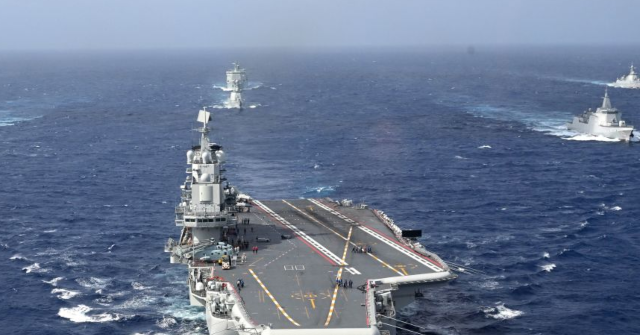The Chinese aircraft carrier Liaoning entered Japan’s Exclusive Economic Zone (EEZ) on Saturday, passing within 200 miles of the eastern island of Minamitori.
It was the first time a Chinese carrier group has sailed through Japan’s eastern waters.
The Liaoning was accompanied by two missile destroyers and a supply ship. After exiting Japan’s EEZ, the carrier group conducted takeoff and landing drills for its fighter jets and helicopters, under the watchful eye of the Japanese warship Haguro.
The Chinese carrier group also passed through the Philippine Sea southwest of Iwo Jima on Sunday.
The Japanese government was clearly uncomfortable with Liaoning’s brief passage through the EEZ, although it evidently stopped short of lodging a formal protest with Beijing. Chief Cabinet Secretary Hayashi Yoshimasa said on Monday that Japan “conveyed an appropriate message to the Chinese side.”
“We think the Chinese military is trying to improve its operational capability and ability to conduct operations in distant areas,” said a spokesman for the Japanese Ministry of Defense.
This should come as no surprise, since the point of spending billions of dollars on developing aircraft carriers is to “conduct operations in distant areas.”
China currently has three aircraft carriers, each more sophisticated than the last, although even the latest model is smaller and less capable than America’s carriers. The Liaoning was the first, an elderly Russian ship China purchased from Ukraine in 1998 and commissioned in 2012. Some Russian politicians have been highly critical of Ukraine for selling the ship to China for “the price of a few bottles of vodka,” as ultranationalist Russian Liberal Democratic Party leader Sergey Karginov put it in a January 2023 tirade.
China’s original plan was to use the Liaoning for testing and training, but it later decided to form a battle group around the ship and dispatch it on intimidating patrols around Taiwan. The People’s Liberation Army Navy (PLAN) apparently feels it has gotten good value for its money (or bottles of vodka) by using its first carrier to conduct military exercises where Taiwan, Japan, and the Philippines can see them.
In September 2024, the Liaoning and its destroyer escorts sailed between the southwestern Japanese islands of Yonaguni and Iriomote, which are close to Taiwan. The Japanese Defense Ministry was not pleased with the Chinese carrier’s course, although it said the Liaoning “did not intrude into Japan’s territorial waters.”
Yonaguni is Japan’s westernmost island, lying within 70 miles of Taiwan’s eastern coast. It is small and picturesque, famed for its natural beauty, scuba diving, and a rare breed of tiny horses. Iriomote is one of the largest islands in the province of Okinawa, but its mountains and heavy forests are largely uninhabited.
The Liaoning’s penetration of Japan’s eastern waters will likely be seen as more provocative in Tokyo than its cruise past the remote tourist islands close to Taiwan. Chinese Foreign Ministry spokesman Lin Jian insisted there was nothing offensive about the Liaoning’s activities on Monday.
“China’s military vessels’ activities in relevant waters are fully consistent with international law and international practices. China pursues a national defense policy that is defensive in nature. We hope Japan will view those activities objectively and rationally,” Lin said.
As for China’s other two carriers, the Shandong was also seen conducting takeoff and landing drills in the Pacific over the weekend, operating about 300 miles southwest of Iwo Jima. Japan dispatched both surface and air assets to monitor the second carrier’s activities.
China’s third and most advanced carrier, the Fujian, was sighted conducting flight operations in the Yellow Sea near South Korea in late May.
Although the South Korean government does not appear to have filed a formal complaint with China, the Fujian reportedly became the first Chinese carrier to operate in a region known as the Provisional Measures Zone (PMZ), an area along the border of China and South Korea’s EEZs that was designated as a deconfliction area 25 years ago.
China suddenly began declaring “no-sail zones” in the PMZ in May, indicating its intention to perform military exercises in those waters. South Korean defense officials said there was little reason for China to send a carrier into the PMZ, other than sending an intimidating message that Beijing can now project naval air power anywhere it wishes.
South Korea’s Chosun Ilbo on Sunday published an editorial linking the activities of China’s three carriers to an effort to expand “Chinese territorial waters” and “build military power against the South Korea-U.S. and Japan-U.S. alliances.”
“Despite the sea’s shallow depth and vulnerability to anti-ship missiles, making it unsuitable for carrier operations, China pressed ahead with combat readiness training. In this zone, where the maritime boundary with South Korea remains undefined, China had already installed fixed structures and large buoys believed to have military purposes. Now it has brought in a carrier as well,” Chosun Ilbo said of Fujian’s activities in the PMZ.
“The Chinese carrier deployed to the West Sea is named Fujian, after the province facing Taiwan, symbolizing Beijing’s intent to unify with the island. If China enters the West Sea during a Taiwan crisis and North Korea miscalculates, what happens to the Korean Peninsula?” the editors wondered.
Satellite photos showed the Fujian returning to its home port on May 29, at which time the PLAN declared its latest carrier had completed its eighth “sea trial.” The Fujian was commissioned in 2022, and could formally enter service within the next year.
Read the full article here
